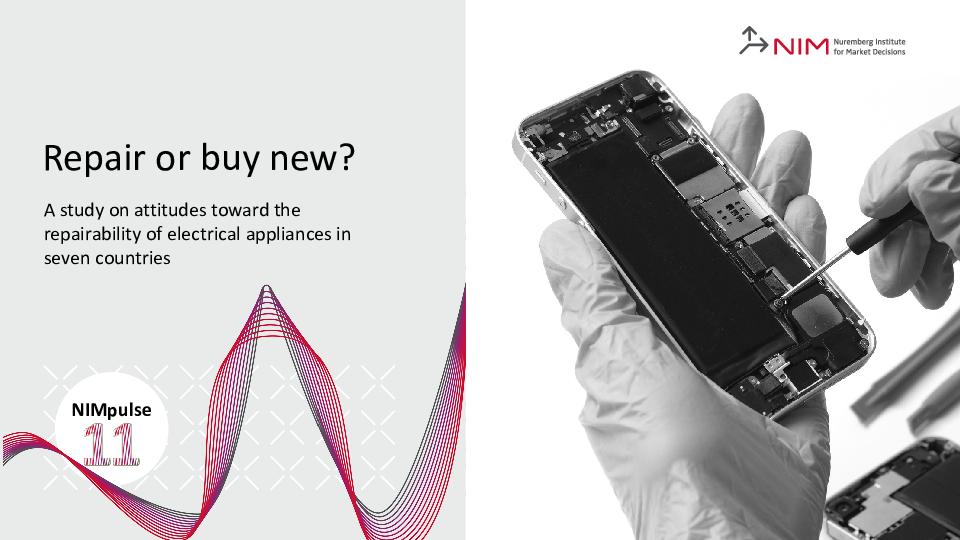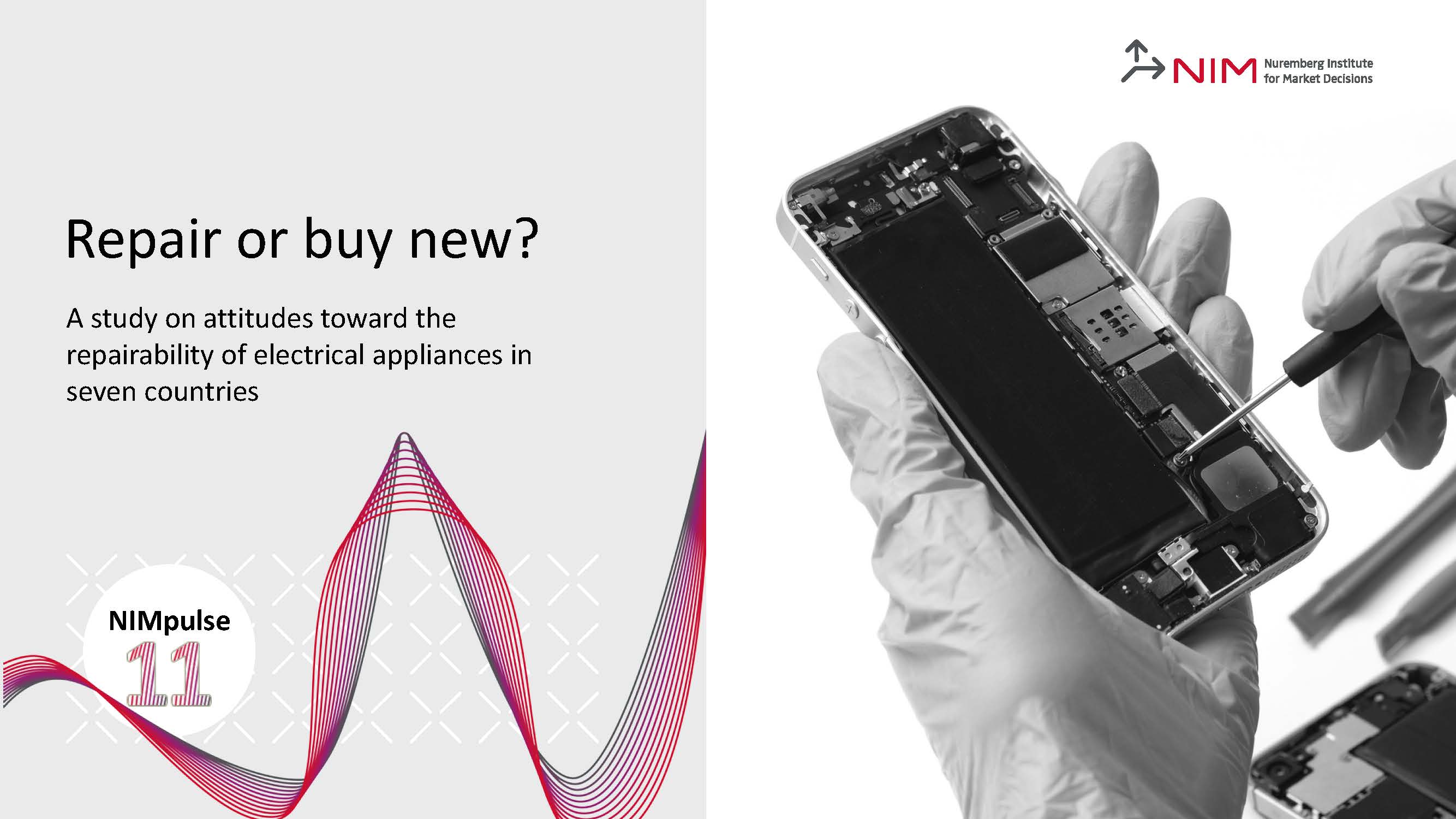Study
 Download
Download
Zürn, M., Unfried, M., & Biró, T. (2025). Repair or buy new? A study on attitudes toward the repairability of electrical appliances in seven countries. NIMpulse 11
2025
Dr. Matthias Unfried,
Tobias Biró
Repair or buy new?
The European Union's new Ecodesign Regulation will come into force in June 2025. It establishes new requirements for smartphone manufacturers with regard to consumer information, product durability, and reparability. The aim is to make electrical appliances more efficient, durable, and resource-friendly. Recycling and the circular economy are also to be strengthened.
E-waste is currently a major and growing problem. According to the UN's Global E-Waste Monitor 2024, 62 million tons of electronic waste were generated worldwide in 2022, an increase of 82% compared to 2010. One way to deal with e-waste is recycling. Another is to repair them so that electronic waste is not generated in the first place.
This study investigated what consumers think about repairs and reparability. Under what conditions is a broken electrical appliance repaired? How high is the willingness to pay? Is there a desire for a stronger repair culture, and what would have to happen for this to become a reality? Ultimately, whether longevity and the circular economy can become a reality also depends on consumers and their market decisions.
In order to better classify national repair behavior, seven countries were considered in the study: Germany, Austria, France, Italy, Poland, the UK, and the USA, five EU countries and two non-EU countries. The study is based on representative surveys of 2,000 adults per country.
How big is the market for repairs?
In most of the countries surveyed, large household appliances are repaired most frequently. In the UK and the USA in particular, this category is far ahead of other categories. Across all product categories, electrical appliances are repaired most frequently in Italy (61%), and in France (43%) and Germany (41%) the least.
In all countries surveyed, a large majority (>75%) would like electrical appliances to be generally easier to repair in the future. This desire is particularly strong in countries where an above-average number of repairs have recently been carried out. For example, the desire for easier repairability is most widespread in Italy (85%), where most residents currently have their electrical appliances repaired.
What are the reasons for repair?
Across all countries, lower costs compared to buying new were the most important reason for a repair. This aspect came first in all countries surveyed. The sustainability aspect plays a different role depending on the region. In Germany, Austria, and France, the desire to conserve resources and protect the environment is a key motivation for repairs. In the USA, on the other hand, this factor is much less important.
Where many respondents cited environmental protection motives as the reason for their decision to repair, no increase in repair behavior can be observed. Examples include France and Germany in particular. Austria is an exception here. There is a much stronger correlation between the propensity to repair and price: the more respondents stated that the repair was cheaper than a new purchase, the more frequently they repaired.
When asked what general conditions need to be met for people to repair rather than buy new, the majority in all countries mention a reasonable price (over 60% in each case). Another important criterion is the guarantee or warranty (approx. 40%), which is also price-related. Conditions such as speed of repair and ease of processing also play a role but are mentioned less frequently than price-related factors.
Costs are the most important criterion in repair decisions. When it comes to the question of what costs consumers consider reasonable for repairs, there is a clear limit, which is around 15% to 20% of the new purchase price, depending on the country. The highest willingness to pay is in Austria, where consumers are prepared to pay an average of 19% of the new purchase price of an appliance. The lowest willingness to pay is in France, the UK, and the USA at 15%.
What are the reasons against repair?
When asked about the reasons that stood in the way of repairing a broken electrical appliance, too high costs came first. This is by far the most frequently cited reason in all countries. "Too much effort" is also frequently mentioned, although this aspect varies greatly in frequency between countries. The desire for a newer model plays a rather subordinate role in all countries.
In Germany in particular, where the high effort is often cited as an obstacle to repairs, consumers are also less likely to repair electrical appliances. By contrast, the repair rate is highest in Italy, where the effort is less frequently perceived as an obstacle. Two countries in particular deviate from this: France, with low values for effort and low repair frequency, and Austria, with high values for effort and medium repair frequency.
Younger people in particular perceive the effort to be particularly high. People with a higher level of education and higher income are also relatively often of the opinion that a repair is too inconvenient compared to a new purchase. The situation is similar when it comes to the desire for a newer model. Apparently, this barrier to repair is particularly widespread among younger people and people with a higher level of education and income.
Costs, especially the difference between repair costs and the price of a new appliance, play a key role in the decision to repair or replace an appliance. In all countries surveyed, consumers would consider repairing an appliance if the cost were less than 20% of the price of a new appliance. However, repair costs in Europe and the US often exceed this figure. Business representatives often argue that consumers are not interested in the reparability of electrical appliances because their desire for newer models outweighs this interest. However, this assumption cannot be substantiated by the available data. Only around 20% of respondents cited the desire for newer models as a reason against repair.
How important is repairability when buying a smartphone?
When buying a smartphone, battery life, price and storage capacity are the most important factors. In contrast, the repairability of a device plays a much smaller role. Other features that indicate a longer service life – such as a longer warranty or regular software updates – are also only rated as particularly important by a small number of people.
In countries where greater attention is paid to the repairability of smartphones when purchasing them, they are also repaired more frequently. This is particularly evident in Italy: 60% of respondents stated that repairability was important to them when buying a smartphone (rank 1). In addition, in the past 12 months, 26% of respondents had their phone repaired at least once (rank 1). Germany and Austria bring up the rear here: in both countries, repairability is the least important factor – and both countries rank last in repair frequency.
Would the repairability of a smartphone play a greater role if the relevant information were more easily accessible? Most consumers assume so. This also applies to people who hardly or not at all considered the repairability of the device when they last bought a smartphone. In this group, too, a majority in all countries surveyed believe that a corresponding label would increase the importance of repairability. This opinion is shared most frequently in Italy and least frequently in Germany.
Should repairability be politically promoted?
When asked whether the state should take measures to promote repairs, approval is high in most countries. One exception is the USA, where a majority rejects state involvement. In European countries, on the other hand, approval is around 80%. In the UK, 77% of respondents are in favor.
How should the state get involved in concrete terms? In many countries, advocates of government measures would like to see stricter requirements for manufacturers. A legal obligation to make spare parts more readily available is particularly popular. A longer warranty on repaired appliances is also strongly advocated. Although the repair label is not one of the most frequently mentioned measures, around one in three supporters consider its introduction to be sensible.
How effective are support measures?
In Austria and France, where nationwide support programs are available, repairs are not carried out more frequently.
Since April 2022, there has been a program in Austria that subsidizes the repair of electrical appliances. The amount of the subsidy is €200 or 50% of the invoice amount per repair. In France, a similar program has been in place since December 2022, which subsidizes the repair of selected electrical appliances with an amount between €7 and €50. In an international comparison, neither Austria nor France stands out due to a particularly high repair frequency.
Both the nationwide program in Austria and the one in France aim to reduce repair costs. In Austria, the level of funding is significantly higher than in France. Nevertheless, the repair costs are perceived as too high in both countries. In Austria, significantly more consumers complain about the high costs than the international average. An above-average number of people in Austria also consider the effort involved to be too high.
The importance of repairability when buying a smartphone can be used as an indicator of repair awareness. However, Austria and France – the two countries with nationwide support programs – do not show increased repair awareness in an international comparison. In Austria, the criterion of repairability even plays a clearly subordinate role when buying a smartphone compared to other countries.
Key Insights
- In principle, the state could be more involved in repairs. A majority in most of the countries surveyed are also in favor of this. Specifically, consumers want manufacturers and retailers to make spare parts more available and for longer.
- Manufacturers should ensure that the design and technology of appliances can be repaired easily and cost-effectively. Consumers want better repairability and could reward manufacturers who act accordingly. Manufacturers are also prepared for corresponding political initiatives.
Retailers could coordinate repairs and reduce the effort required on the part of consumers. The effort involved is one of the most frequently cited hurdles
in the context of repairs. Retailers should also play a prominent role in educating consumers about repairability.- Consumers can be persuaded by low costs and little effort. The potential is there: a majority of consumers are open to repairing more and using electrical appliances for longer.
The study and questionnaire were designed by the Nuremberg Institute for Market Decisions (NIM). The data was collected via NIQ/GfK in online access panels. A total of 14,000 people aged between 18 and 74 were surveyed, representing a representative sample of the (online) population in the seven countries. The survey was conducted between 27 February 2025 and 13 March 2025.
Authors
- Dr. Michael K. Zürn, Senior Researcher, NIM, michael.zuern@nim.org
- Dr. Matthias Unfried, Head of Behavioral Science, NIM, matthias.unfried@nim.org
- Tobias Biró, Head of Research Communication, NIM, tobias.biro@nim.org
Contact

